The Effect of Shank-Space on the Thermal Performance of Shallow Vertical U-Tube Ground Heat Exchangers
Abstract
1. Introduction
2. The Ground Source Heat Pump—A Short Review
3. Parameters Affecting the System Performance
3.1. Effect of Shank-Space on System Performance
3.2. Effect of Spatial Arrangement and Borehole Spacing
4. Scope of Research
5. Methodology
5.1. Computational Domain of the Isolated Ground Heat Exchanger
5.2. Establishing the Boundary Conditions
5.3. Computational Domain of the Ground Heat Exchanger Array
5.4. Solution Methods
6. Results and Discussions
6.1. Varying the Shank-Space for a 20 m Borehole
6.2. Varying the Shank-Space for a 40 m Borehole
6.3. Isolated Borehole Energetic Analysis
6.4. Effect of Borehole Spacing
7. Conclusions
Author Contributions
Funding
Acknowledgments
Conflicts of Interest
References
- Buildings Performance Institute Europe. Europe’s Buildings under the Microscope—A Country-by-Country Review of the Energy Performance of Buildings. Available online: http://bpie.eu/wpcontent/uploads/2015/10/HR_EU_B_under_microscope_study.pdf (accessed on 19 October 2017).
- Connolly, D. Heat Roadmap Europe: Quantitative comparison between the electricity, heating, and cooling sectors for different European countries. Energy 2017, 139, 580–593. [Google Scholar] [CrossRef]
- European Commission. Energy Efficiency—Heating and Cooling. Available online: https://ec.europa.eu/energy/en/topics/energy-efficiency/heating-and-cooling (accessed on 19 October 2017).
- Naranjo-Mendozaa, C.; Oyinlolab, M.A.; Wright, A.J.; Greenough, R.M. Experimental study of a domestic solar-assisted ground source heat pump with seasonal underground thermal energy storage through shallow boreholes. Appl. Sci. 2019, 162, 114–218. [Google Scholar] [CrossRef]
- Carvalho, A.D. High Efficiency Ground Source Heat Pump Systems for Sustainable Building Space Conditioning. Ph.D. Thesis, University of Coimbra, Coimbra, Portugal, 2015. [Google Scholar]
- Wu, R. Energy efficiency technologies—Air source heat pump vs. ground source heat pump. J. Sustain. Dev. 2009, 2, 14–23. [Google Scholar] [CrossRef]
- Dehghan, B.; Sisman, A.; Aydin, M. Optimizing the distance between boreholes with helical shaped ground heat exchanger. In Proceedings of the World Geothermal Congress, Melbourne, Australia, 19–25 April 2015. [Google Scholar]
- Self, S.J.; Reddy, B.V.; Rosen, M.A. Geothermal heat pump systems: Status review and comparison with other heating options. Appl. Sci. 2013, 101, 341–348. [Google Scholar] [CrossRef]
- Wołoszyn, J.; Gołaś, A. Coefficient of Performance Stabilisation in Ground Source Heat Pump Systems. J. Sustain. Dev. Energy Water Environ. Syst. 2017, 5, 645–656. [Google Scholar] [CrossRef][Green Version]
- Florides, G.; Kalogirou, S. Ground heat exchangers. A review of systems, models and applications. Renew. Energy 2007, 32, 2461–2478. [Google Scholar] [CrossRef]
- Spitler, J.D.; Gehlin, S.E.A. Thermal response testing for ground source heat pump systems-A historical review. Renew. Sustain. Energy Rev. 2015, 50, 1125–1137. [Google Scholar] [CrossRef]
- Yang, H.; Cui, P.; Fang, Z. Vertical-borehole ground-coupled heat pumps: A review of models and systems. Appl. Energy 2010, 87, 16–27. [Google Scholar] [CrossRef]
- Zanchini, E.; Jahanbin, A. Effects of the temperature distribution on the thermal resistance of double u-tube borehole heat exchangers. Geothermics 2018, 71, 46–54. [Google Scholar] [CrossRef]
- Naicker, S.S.; Rees, S.J. Long-term high frequency monitoring of a large borehole heat exchanger array. Renew. Energy 2020, 145, 1528–1542. [Google Scholar] [CrossRef]
- Omer, A.M. Ground-source heat pumps systems and applications. Renew. Sustain. Energy Rev. 2008, 2, 344–371. [Google Scholar] [CrossRef]
- Claesson, J.; Javed, S. Explicit Multipole Formulas for Calculating Thermal Resistance of Single U-Tube. Ground Heat Exchangers. Energies 2018, 11, 214. [Google Scholar] [CrossRef]
- Javed, S.; Spitler, J. Accuracy of borehole thermal resistance calculation methods for grouted single U-tube ground heat exchangers. Appl. Energy 2017, 187, 790–806. [Google Scholar] [CrossRef]
- Wagner, V.; Bayer, P.; Kübert, M.; Blum, P. Numerical sensitivity study of thermal response tests. Renew. Energy 2012, 41, 245–253. [Google Scholar] [CrossRef]
- Dehkordi, S.E.; Schincariol, R.A.; Reitsma, S. Thermal performance of a tight borehole heat exchanger. Renew. Energy 2015, 33, 698–704. [Google Scholar] [CrossRef]
- Li, Y.; Mao, J.; Geng, S.; Han, X.; Zhang, H. Evaluation of thermal short-circuiting and influence on thermal response test for borehole heat exchangers. Geothermics 2014, 50, 136–147. [Google Scholar] [CrossRef]
- Sharqawy, M.H.; Mokheimer, E.M.; Badr, H.M. Effective pipe-to-borehole thermal resistance for vertical ground heat exchangers. Geothermics 2009, 38, 271–277. [Google Scholar] [CrossRef]
- Makasis, N.; Narsilio, G.A.; Bidarmaghz, A.; Johnston, I.W. Ground-source heat pump systems: The effect of variable pipe separation in ground heat exchangers. Comput. Geotech. 2018, 100, 97–109. [Google Scholar] [CrossRef]
- Huang, S.; Ma, Z.; Wang, F. A multi-objective design optimization strategy for vertical ground heat exchangers. Energy Build. 2015, 87, 233–242. [Google Scholar] [CrossRef]
- Zhou, K.; Mao, J.; Li, J.; Xiang, J. Parameters optimization of borehole and internal thermal resistance for single U-tube ground heat exchangers using Taguchi method. Energy Convers. Manag. 2019, 201, 112–177. [Google Scholar] [CrossRef]
- Zanchini, E.; Jahanbin, A. Simple equations to evaluate the mean fluid temperature of double U-tube borehole heat exchangers. Appl. Energy 2018, 231, 320–330. [Google Scholar] [CrossRef]
- Naldi, C.; Zanchini, E. Effect of the borehole thermal resistance on the performance of a ground-coupled heat pump system. In Proceedings of the SET2017, Bologna, Italy, 17–20 July 2017. [Google Scholar]
- Witte, H. A parametric sensitivity study into borehole performance design parameters. In Proceedings of the 12th International Conference on Energy Storage, Lleida, Spain, 16–18 May 2012; Available online: http://www.groenholland.nl/download/INNOS-U33-PARSENS.pdf (accessed on 28 January 2020).
- Zheng, Z.; Wang, W.; Ji, C. A study on the thermal performance of vertical U-tube ground heat exchangers. Energy Procedia 2011, 12, 906–914. [Google Scholar] [CrossRef]
- Cui, Y.; Zhu, J. 3D transient heat transfer numerical analysis of multiple energy piles. Energy Build. 2017, 134, 129–142. [Google Scholar] [CrossRef]
- Casasso, A.; Sethi, R. Assessment and Minimization of Potential Environmental Impacts of Ground Source Heat Pump (GSHP) Systems. Water 2019, 11, 1573. [Google Scholar] [CrossRef]
- Galea, D. Design of a Shallow Ground Geothermal Heat Pump System for Space Conditioning of Buildings. Master’s Thesis, Institute for Sustainable Energy, University of Malta, Msida, Malta, 2015. [Google Scholar]
- Warner, J.; Liu, X.; Shi, L.; Qu, M.; Zhang, M. A novel shallow bore ground heat exchanger for ground source heat pump applications—Model development and validation. Appl. Therm. Eng. 2020, 164, 114460. [Google Scholar] [CrossRef]
- Bina, S.M.; Fujii, H.; Tsuya, S.; Kosukegawa, H.; Naganawa, S.; Harada, R. Evaluation of utilizing horizontal directional drilling technology for ground source heat pumps. Geothermics 2020, 85, 101769. [Google Scholar] [CrossRef]
- Zhang, M.; Liu, X.; Biswas, K.; Warner, J. A three-dimensional numerical investigation of a novel shallow bore ground heat exchanger integrated with phase change material. Appl. Therm. Eng. 2019, 162, 114297. [Google Scholar] [CrossRef]
- Tang, F.; Nowamooz, H. Factors influencing the performance of shallow borehole heat exchanger. Energy Convers. Manag. 2019, 181, 571–583. [Google Scholar] [CrossRef]
- Gultekin, A.; Aydin, M.; Sisman, A. Thermal performance analysis of multiple borehole heat exchangers. Energy Convers. Manag. 2016, 122, 544–551. [Google Scholar] [CrossRef]
- Janiszewski, M.; Caballero Hernández, E.; Siren, T.; Uotinen, L.; Kukkonen, I.; Rinne, M. In Situ Experiment and Numerical Model Validation of a Borehole Heat Exchanger in Shallow Hard Crystalline Rock. Energies 2018, 11, 963. [Google Scholar] [CrossRef]
- ANSYS Fluent 16.2, Ansys. 2016. Available online: https://www.ansys.com/products/fluids/ansys-fluent (accessed on 28 January 2020).
- Sagia, Z.; Stegou, A.; Rakopoulos, C. Borehole resistance and heat conduction around vertical ground heat exchangers. Open Chem. Eng. J. 2012, 6, 32–40. [Google Scholar] [CrossRef][Green Version]
- Borg, D. The Potential of Introducing Ground Source Heat Pumps in Malta. Bachelor’s Thesis, Faculty for the Built Environment, University of Malta, Msida, Malta, 2011. [Google Scholar]
- Sciberras, L. Understanding the Variables Affecting Ground Source Heat Exchangers. Master’s Thesis, Faculty for the Built Environment, University of Malta, Msida, Malta, 2016. [Google Scholar]
- Hajdukiewicz, M.; Walsh, M.; Keane, M.M. Formal Calibration methodology for a CFD model of a naturally ventilated room. Presented at the 12th International IBPSA Conference (BS 2011), Sydney, Australia, 14–16 November 2011. [Google Scholar]
- Qi, D.; Pu, L.; Sun, F.; Li, Y. Numerical investigation on thermal performance of ground heat exchangers using phase change materials as grout for ground source heat pump system. Appl. Therm. Eng. 2016, 106, 1023–1032. [Google Scholar] [CrossRef]
- Claesson, J.; Dunand, A. Heat Extraction from the Ground by Horizontal Pipes: A Mathematical Analysis; Swedish Council for Building Research: Stockholm, Sweden, 1983. [Google Scholar]
- Gu, Y.; O’Neal, D. Development of an equivalent diameter expression for vertical U-tubes used in ground-coupled heat pumps. ASHRAE Trans. 1998, 104, 347–355. [Google Scholar]
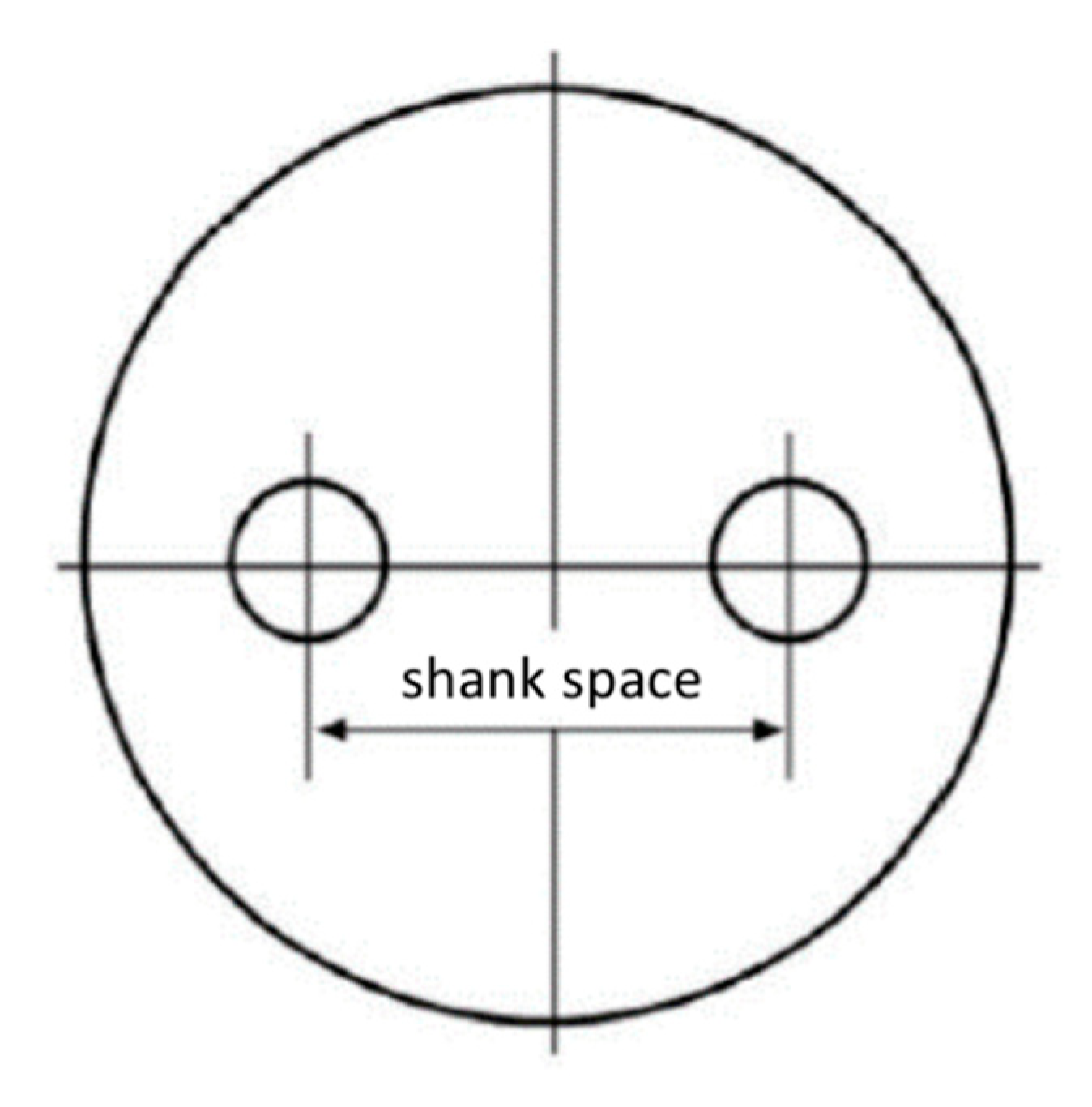
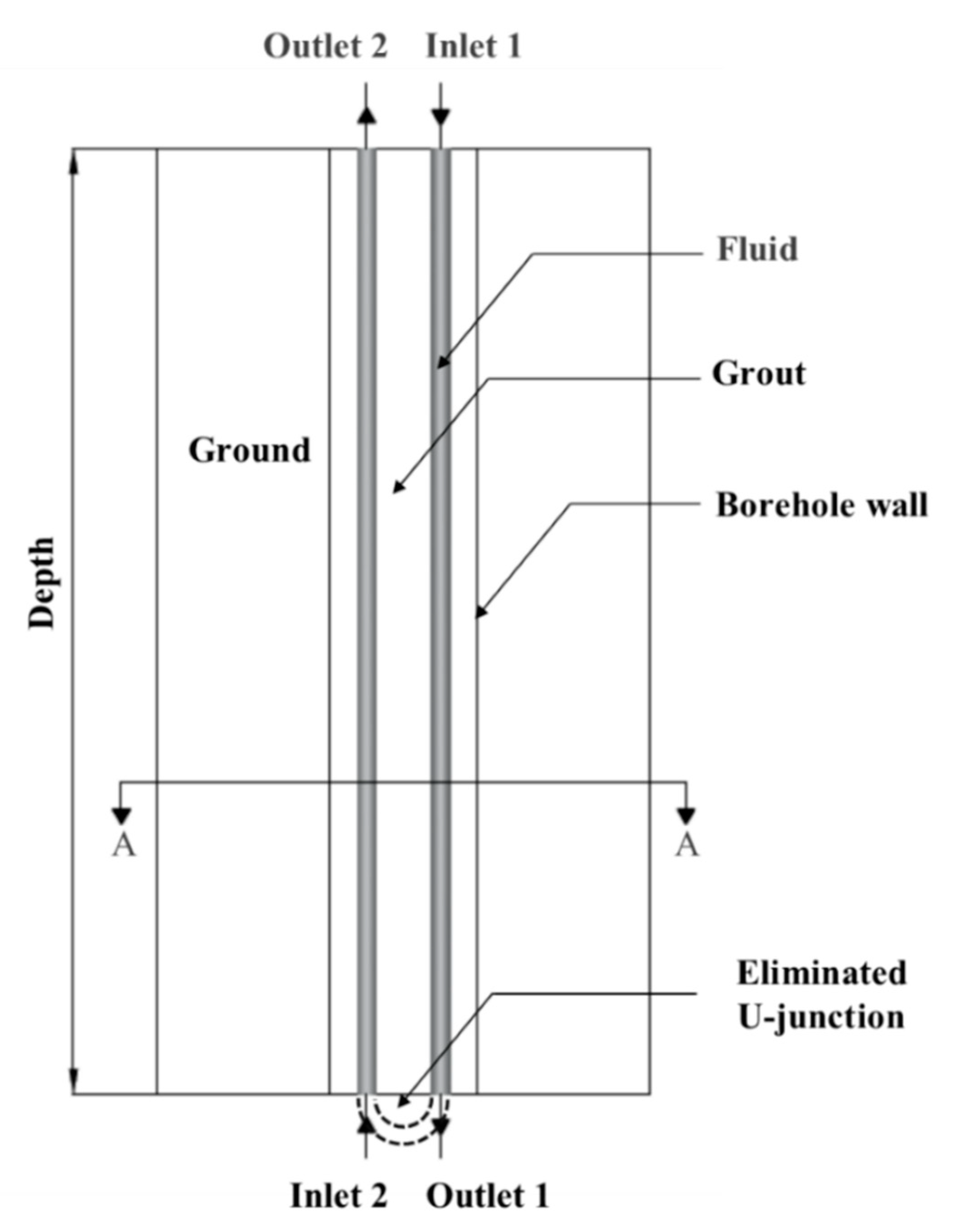
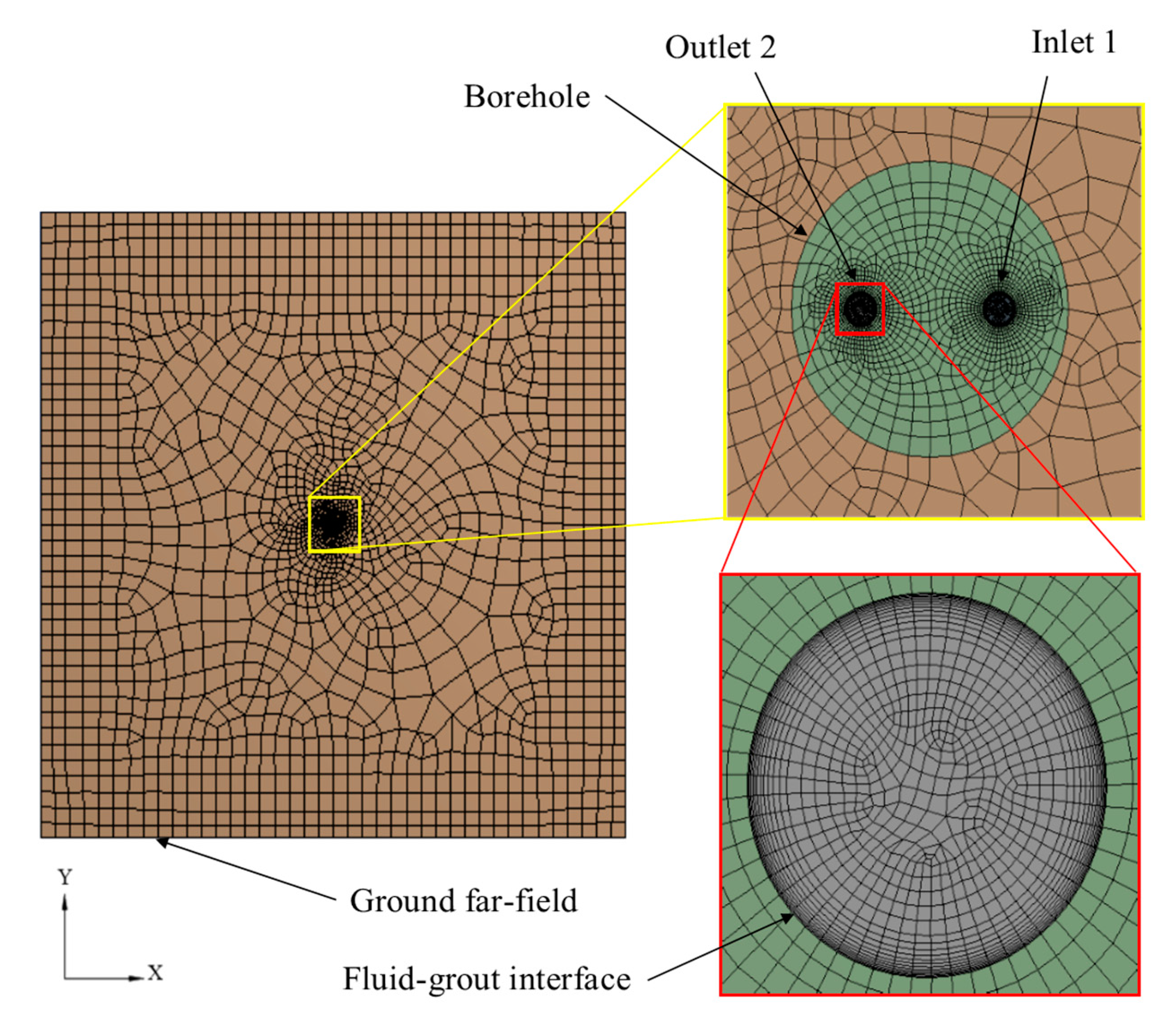
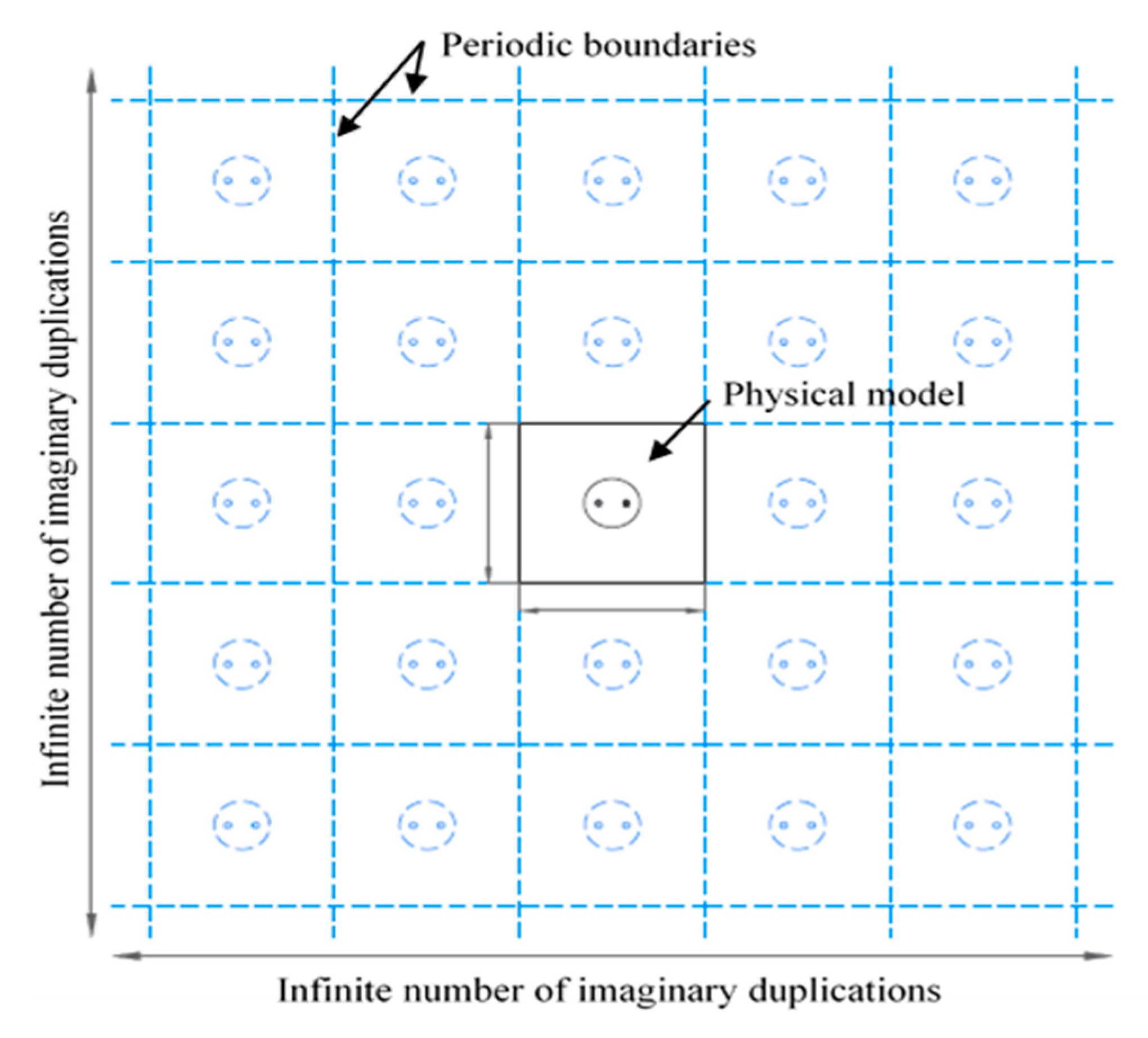
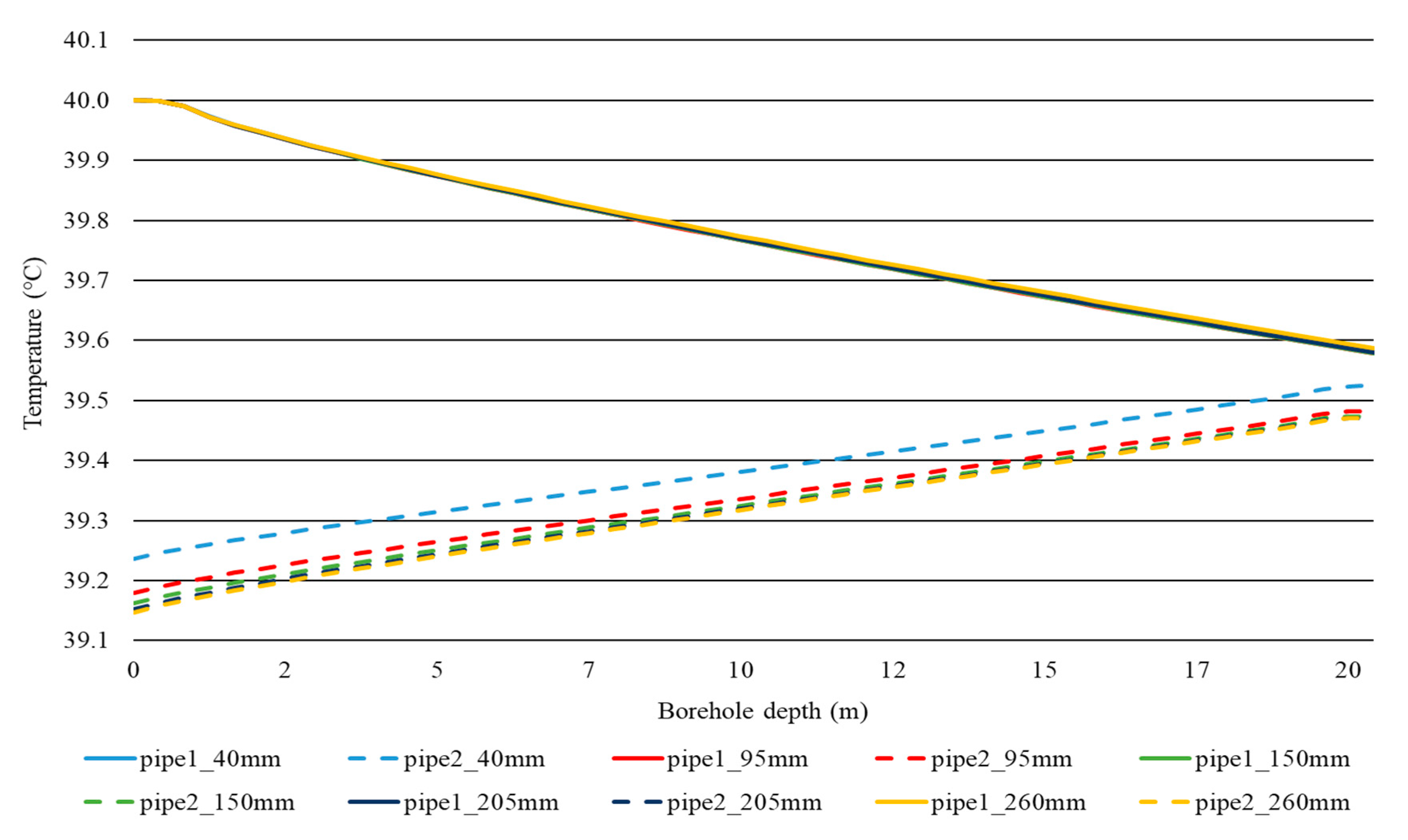
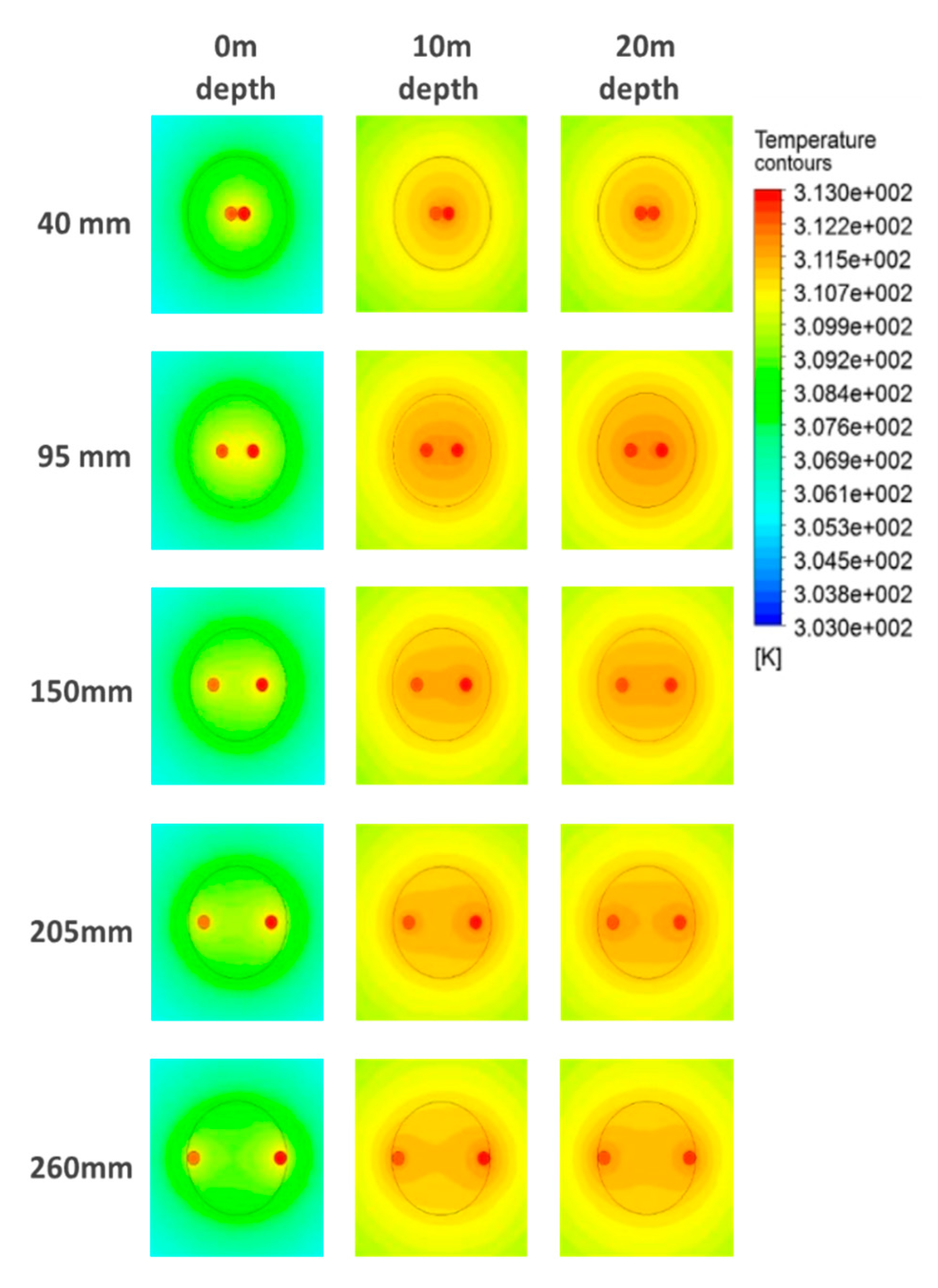
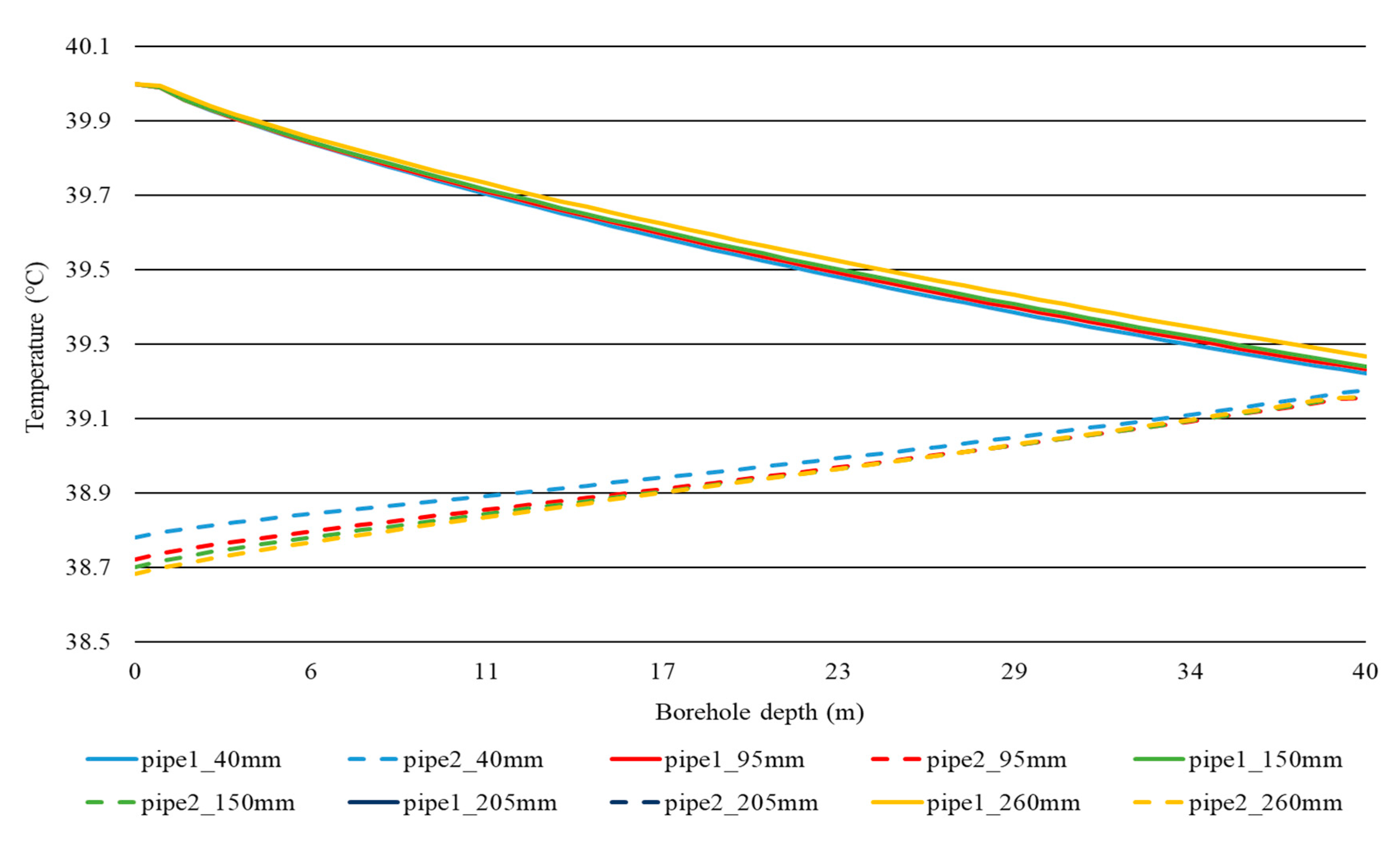

| Component | Material | Thermal Conductivity (W/mK) | Density (kg/m3) | Specific Heat Capacity (J/kgK) |
|---|---|---|---|---|
| Fluid | Water | 0.60 | 998 | 4182 |
| Pipe | Low-density Polyethylene | 0.33 | 940 | 1900 |
| Grout | Artificial High Conductivity Material | 6.5 | 2327 | 880 |
| Ground | Calcium Carbonate | 2.25 | 2800 | 856 |
| Shank-Space (mm) | Inlet 1 Temp. (°C) | Outlet 1 Temp. (°C) | Inlet 2 Temp. (°C) | Outlet 2Temp. (°C) | Temp. Drop (Inlet 1-Outlet 2) (°C) | Improvement over Previous Shank-Space (%) |
|---|---|---|---|---|---|---|
| 40 | 40.00 | 39.58 | 39.53 | 39.24 | 0.76 | - |
| 95 | 40.00 | 39.58 | 39.48 | 39.18 | 0.82 | 7.9 |
| 150 | 40.00 | 39.58 | 39.47 | 39.16 | 0.84 | 2.4 |
| 205 | 40.00 | 39.58 | 39.47 | 39.15 | 0.85 | 1.2 |
| 260 | 40.00 | 39.59 | 39.47 | 39.15 | 0.85 | 0.0 |
| Shank-Space (mm) | Inlet 1 Temp. (°C) | Outlet 1 Temp. (°C) | Inlet 2 Temp. (°C) | Outlet 2 Temp. (°C) | Temp. Drop (Inlet 1-Outlet 2) (°C) | Improvement over Previous Shank-Space (%) |
|---|---|---|---|---|---|---|
| 40 | 40.00 | 39.22 | 39.18 | 38.78 | 1.22 | - |
| 95 | 40.00 | 39.23 | 39.16 | 38.72 | 1.28 | 4.92 |
| 150 | 40.00 | 39.24 | 39.16 | 38.70 | 1.30 | 1.56 |
| 205 | 40.00 | 39.25 | 39.16 | 38.69 | 1.31 | 0.77 |
| 260 | 40.00 | 39.27 | 39.16 | 38.68 | 1.32 | 0.77 |
| Shank-Space (mm) | 20 m Deep Borehole Temp. Drop (Inlet 1 - Outlet 2) (°C) | 40 m Deep Borehole Temp. Drop (Inlet 1 - Outlet 2) (°C) | Depth Based Improvement (%) |
|---|---|---|---|
| 40 | 0.76 | 1.22 | 60.53 |
| 95 | 0.82 | 1.28 | 56.10 |
| 150 | 0.84 | 1.30 | 54.76 |
| 205 | 0.85 | 1.31 | 54.12 |
| 260 | 0.85 | 1.32 | 55.29 |
| Borehole Spacing (m) | Inlet 1 Temp. (°C) | Outlet 1 Temp. (°C) | Inlet 2 Temp. (°C) | Outlet 2Temp. (°C) | Temp. Drop (Inlet 1-Outlet 2) (°C) |
|---|---|---|---|---|---|
| 5 | 40.00 | 39.89 | 39.89 | 39.81 | 0.19 |
| 10 | 40.00 | 39.79 | 39.76 | 39.60 | 0.40 |
| 15 | 40.00 | 39.71 | 39.65 | 39.43 | 0.57 |
© 2020 by the authors. Licensee MDPI, Basel, Switzerland. This article is an open access article distributed under the terms and conditions of the Creative Commons Attribution (CC BY) license (http://creativecommons.org/licenses/by/4.0/).
Share and Cite
Vella, C.; Borg, S.P.; Micallef, D. The Effect of Shank-Space on the Thermal Performance of Shallow Vertical U-Tube Ground Heat Exchangers. Energies 2020, 13, 602. https://doi.org/10.3390/en13030602
Vella C, Borg SP, Micallef D. The Effect of Shank-Space on the Thermal Performance of Shallow Vertical U-Tube Ground Heat Exchangers. Energies. 2020; 13(3):602. https://doi.org/10.3390/en13030602
Chicago/Turabian StyleVella, Christopher, Simon Paul Borg, and Daniel Micallef. 2020. "The Effect of Shank-Space on the Thermal Performance of Shallow Vertical U-Tube Ground Heat Exchangers" Energies 13, no. 3: 602. https://doi.org/10.3390/en13030602
APA StyleVella, C., Borg, S. P., & Micallef, D. (2020). The Effect of Shank-Space on the Thermal Performance of Shallow Vertical U-Tube Ground Heat Exchangers. Energies, 13(3), 602. https://doi.org/10.3390/en13030602






